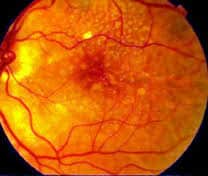Macular Degeneration

What is Macular Degeneration?
Age-related macular degeneration (AMD) is a disease associated with aging that gradually destroys sharp, central vision. Central vision is needed for seeing objects clearly and for common daily tasks such as reading and driving.
About Macular Degeneration
The macula is the part of the retina that is responsible for your central vision, allowing you to see fine details clearly. The macula is a small area in the retina. It is actually the light-sensitive tissue lining the back of the eye. Age-related macular degeneration (AMD) is a deterioration or breakdown of the eye’s macula. When macular degeneration sets in, deterioration of central vision begins. Macular degeneration is one of the leading causes of decreased vision in the United States in patients over age 50. Many older people develop macular degeneration as part of the natural aging process. There are different kinds of macular problems, but the most common is age-related macular degeneration. People with macular degeneration may have symptoms such as blurriness, dark areas or distortion in your central vision, and perhaps permanent loss of your central vision. It usually does not affect your side, or peripheral vision.
Types of Macular Degeneration:
Macular Degeneration is an age related eye disease that causes loss of central vision and typically comes in two forms known as dry macular degeneration and wet macular degeneration.
- “Dry” form – the most common form usually progresses slowly and causes central vision loss. Dry AMD occurs when the light-sensitive cells in the macula slowly break down, gradually blurring central vision in the affected eye. As dry AMD gets worse, you may see a blurred spot in the center of your vision. Over time, as less of the macula functions, central vision is gradually lost in the affected eye. The most common symptom of dry AMD is slightly blurred vision. You may have difficulty recognizing faces. You may need more light for reading and other tasks. Dry AMD generally affects both eyes, but vision can be lost in one eye while the other eye seems unaffected.
- “Wet” form – rare, and more severe. May progress rapidly causing significant central vision loss. Wet AMD occurs when abnormal blood vessels behind the retina start to grow under the macula. These new blood vessels tend to be very fragile and often leak blood and fluid. The blood and fluid raise the macula from its normal place at the back of the eye. Damage to the macula occurs rapidly. With wet AMD, loss of central vision can occur quickly. Wet AMD is also known as advanced AMD. It does not have stages like dry AMD.
Macular Degeneration Symptoms:
- Straight lines look wavy and too curved (amsler grid)
- Shapes are blurry and not readable
- Words appear blurred or difficult to read
- Colors look dull and dim
- There appears to be a fog in the center of your vision
- Dark or blank areas block the center of your vision
Macular Degeneration Risk Factors:
- People with diabetes (adults or aging seniors)
- Those who smoke cigarettes – this increases the risk of ARMD
- People with uncontrolled high blood pressure
- Those with a family history of macular degeneration
- People that lack sufficient ability to absorb nutrients through their digestive system.
If you are over the age of 60, and have not had a routine eye exam , we highly recommend calling Morristown Ophthalmology Associates, P.A. to schedule an appointment to look for early signs of this degenerative eye disease.





